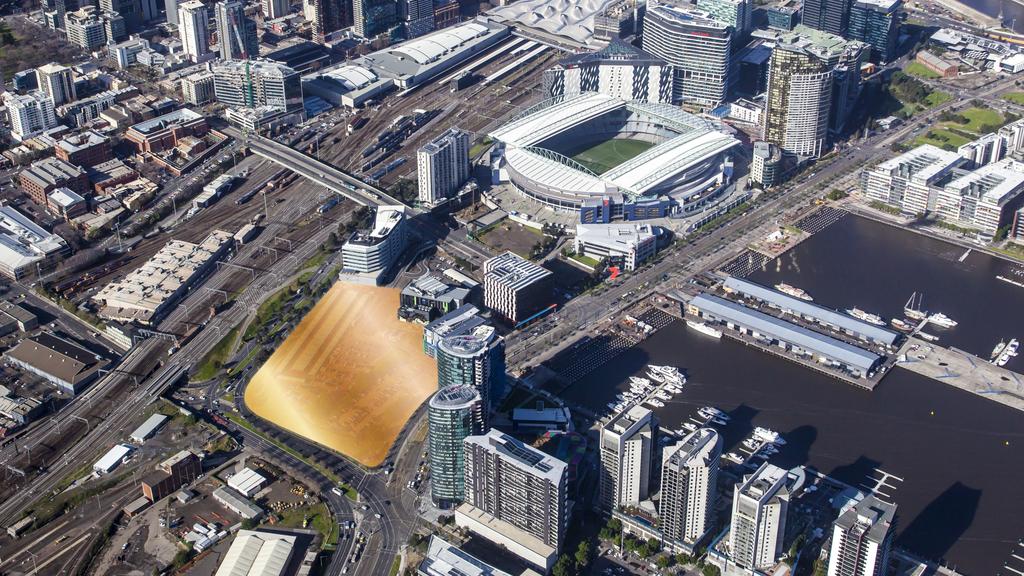Developer Tim Gurner’s $1.75bn Docklands project that will reinvigorate the inner-city precinct

Developer Tim Gurner plans on delivering a $1.75bn development at Melbourne’s Docklands.
Prolific developer Tim Gurner is not allowing construction constraints or the pandemic to slow his momentum, shoring up his multibillion-dollar pipeline of work with a $1.75bn “city-changing” project in Melbourne.
Positioned near to Marvel Stadium in the Docklands, Mr Gurner will partner with development consortium City Harbour – backed by the wealthy Liberman family – to deliver the new mixed-use precinct, although the terms have not been not disclosed.
The project adds to the more than $10bn pipeline of work under way down the east coast of Australia as well as in Adelaide – and follows the developer’s commitment to Queensland last week with a number of new hirings and a Brisbane office.
While some listed rivals are all but out of the market and smaller players can’t obtain finance, Mr Gurner believes the scale of the Melbourne precinct will rival the awe-inspiring buildings of Singapore, New York or London.
“As the business continues to diversify and grow we are heavily focused on large-scale, mixed-use precincts like this where we can create something with a real point of difference and enough scale to transform the area around it,” he said.
“This will be like nothing ever delivered in Melbourne and really put Docklands on the global map.”
The properties in Melbourne’s City Harbour precinct, between the CBD and Melbourne’s waterfront, are better known for office blocks and earlier this year the consortium sold two towers to Singapore’s Straits Real Estate.

The location of the $1.75bn site at Docklands in Melbourne.
But the Docklands is seeing a burst of new projects.
Daniel Grollo-backed, build-to-rent developer Home Residential is building two towers next to Marvel Stadium and AsheMorgan is overhauling the 10ha The District Docklands precinct.
Designs for Mr Gurner’s 18,000sq m site, pegged as a “botanical destination”, are still being finalised. Inspiration for the public realm is coming from some of the world’s largest cities and it’s hoped that the completed project will be a major drawcard, not only for Docklands residents but the recovering tourism market.
Each of the towers at the site will be distinct in its character, form and function and draw upon ambitious architecture from Singapore, Dubai, London and New York. Luxury residential apartments will be in the mix alongside build-to-rent, a hotel and sky-high hospitality venues.
“We’ve taken cues from some of the best architects in the world and some of my favourite designers; each tower will be distinct in its identity, centred around the ‘creation’ in the centre of the site, with additional public land and amenities, interaction between each tower and world-class, mixed-use spaces,” Mr Gurner said.
“We are committed to helping Docklands become what we all know it must for our city, to get back its claim as the world’s most liveable city. Docklands is the biggest opportunity in Melbourne for a world-class precinct and we look forward to adding to its future.”

Melbourne from the air looking west across Docklands showcasing Marvel Stadium and the Bolte Bridge. Picture: Mark Stewart
The site – bordered by Wurundjeri Way, Dudley St, La Trobe St and Harbour Esplanade – has Quay and harbour-front views, and will become the entrance to the city and Docklands from Melbourne’s west.
Mr Gurner last week told The Australian his experience through the tough building conditions of 2015 and 2016 has positioned him well for the current “profitless boom” which has already claimed several builders and projects.
A similar project to Docklands is under way on the Gold Coast. The $1.5bn La Pelago island precinct is expected to hit the market sometime in 2023, featuring four residential towers and a hotel. Other projects under way in the Sunshine State include Mr Gurner’s recently acquired Burleigh development and a 250-plus apartment project in Brisbane’s Fortitude Valley.
Queensland will account for a growing portion of Mr Gurner’s total pipeline over the next five years as the southeast corner readies for the 2032 Olympic Games and continues to see strong interstate migration flows.
“The next 12 months are going to be a huge test,” Mr Gurner said.
“The world is looking pretty fragile, and we think there’ll be a lot of opportunities that will come out of that fragility. Interest rates have moved up, capital costs have moved up significantly, construction (costs) have moved up significantly over the last 12 months, particularly in Perth and Queensland. That’s going to hurt a lot of people, unfortunately.
“That fragmentation in the market is why we are setting a bit more of a base (in Queensland) – to be a larger developer who can get through the harder times and see the opportunities through the next 12 months, which is going to be a big test.”







